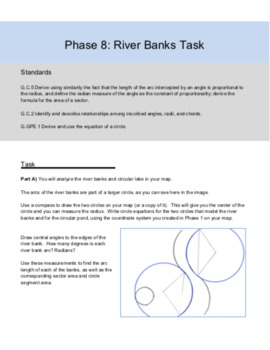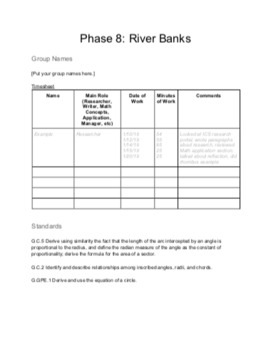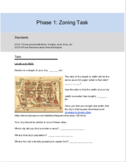HS Geometry City River Banks Project - Circles, Arc Lengths, Sector Areas, etc.
Keith Sheridan
39 Followers
Grade Levels
9th - 12th
Subjects
Standards
CCSSHSG-C.A.2
CCSSHSG-C.A.3
CCSSHSG-C.A.4
CCSSHSG-C.B.5
CCSSHSG-MG.A.1
Formats Included
- Zip
Keith Sheridan
39 Followers
Also included in
- This is a bundle of all my city design projects for teaching Geometry.The projects are:Phase 1 City Design - Points, Lines, Planes, Angles, Distance, MidpointPhase 2 Urban Planning - Logic, Conditionals, ProofsPhase 3 Transportation - Parallel, Perpendicular, Equations of LinesPhase 4 Structures - TPrice $20.00Original Price $24.00Save $4.00
Description
This project leads student through the Circle unit of Geometry in learning about Arc Length, Sector Area, Segment Area, Lines in Circles, and Circle Equations. Students will analyze the river banks in their designed city (free resource here) and use it to demonstrate these concepts.
This purchase includes a task sheet for students describing the project, a report template for students to provide their information, a rubric, tips on helping students with research, and tips on running the project based on my experience teaching it. Files come in both PDF and DOC so you can tailor them to your needs.
Total Pages
Answer Key
N/A
Teaching Duration
N/A
Report this resource to TPT
Reported resources will be reviewed by our team. Report this resource to let us know if this resource violates TPT’s content guidelines.
Standards
to see state-specific standards (only available in the US).
CCSSHSG-C.A.2
Identify and describe relationships among inscribed angles, radii, and chords.
CCSSHSG-C.A.3
Construct the inscribed and circumscribed circles of a triangle, and prove properties of angles for a quadrilateral inscribed in a circle.
CCSSHSG-C.A.4
Construct a tangent line from a point outside a given circle to the circle.
CCSSHSG-C.B.5
Derive using similarity the fact that the length of the arc intercepted by an angle is proportional to the radius, and define the radian measure of the angle as the constant of proportionality; derive the formula for the area of a sector.
CCSSHSG-MG.A.1
Use geometric shapes, their measures, and their properties to describe objects (e.g., modeling a tree trunk or a human torso as a cylinder).




